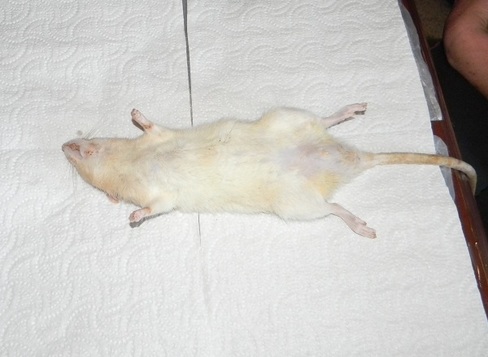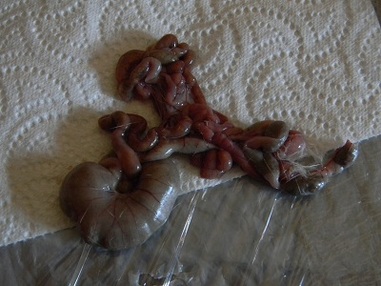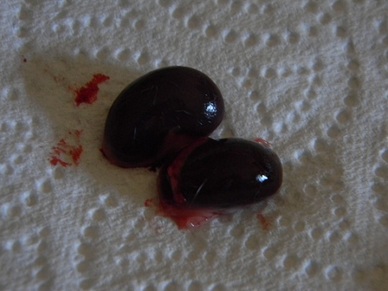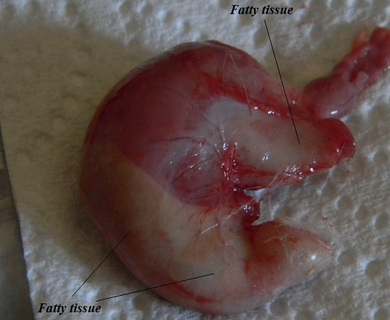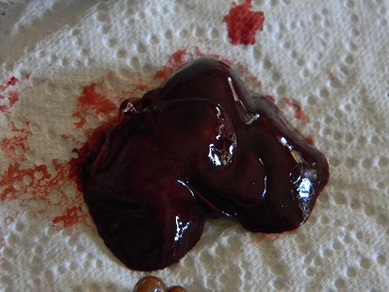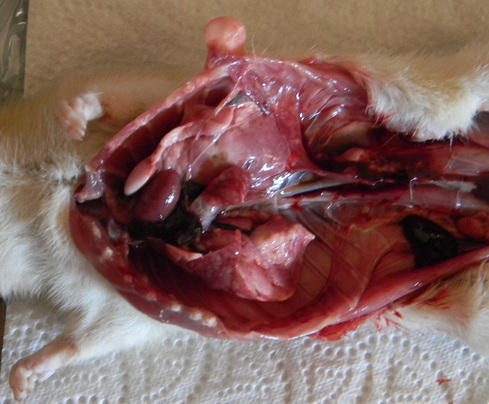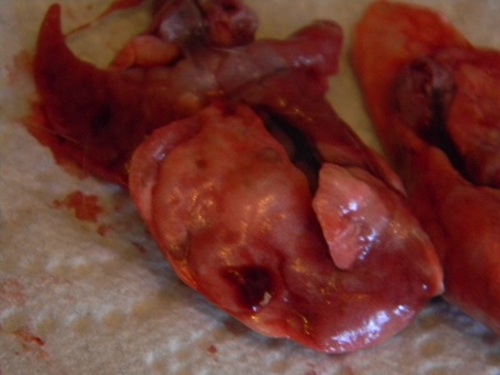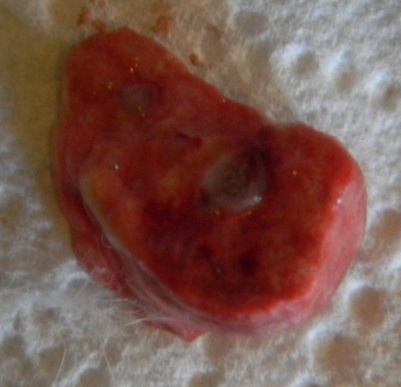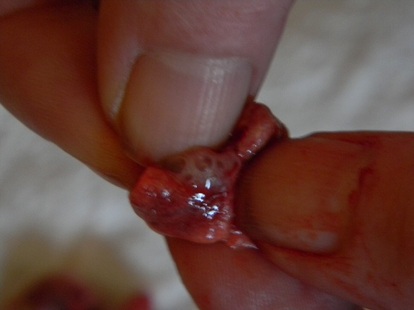15 month old male rat with severe respiratory infection.
WARNING: THIS PAGE CONTAINS GRAPHIC IMAGES OF A RAT DISSECTION.
* Heath history of subject
This male had suffered from Mycoplasma infections periodically for 6 months prior to his death. It is important to note that this male was by no means in the final terminal stage of the infection. Signs of the final stages of respiratory infections such as open mouthed breathing and muscle degeneration were not yet present (despite the fact that many pet owners still make attempts to bring their rats back from this stage of infection).
He had been treated with both Doxycycline and Baytril in an effort to clear up his infection. Bisolvon has been used during his sickness to clear up the excess fluid that was building up in his lungs as a result of the bacteria. Despite attempts to clear his lungs after the dissection it had become very clear that even after treatment with various antibiotics, the damage to the lungs was permanent and the rats respiratory system makes little to no recovery.
* Treatment history
i have had a few requests to know a little more about the history of treatment this particular rat has gone though. He has been treated once or twice for major flair ups with a match head sized dose of doxy paste and .2ml Baytril twice a day for a minimum period of two weeks. Prior to this his infections had been managed effectively by the use of Bisolvon.
* Symptoms prior to death
Obvious extreme trouble inhaling and exhaling air (not yet opening mouth to breathe). Hunched over and weak. Rat made no attempts to correct himself when placed in an awkward position. his coat had become brittle and dull.
This male had suffered from Mycoplasma infections periodically for 6 months prior to his death. It is important to note that this male was by no means in the final terminal stage of the infection. Signs of the final stages of respiratory infections such as open mouthed breathing and muscle degeneration were not yet present (despite the fact that many pet owners still make attempts to bring their rats back from this stage of infection).
He had been treated with both Doxycycline and Baytril in an effort to clear up his infection. Bisolvon has been used during his sickness to clear up the excess fluid that was building up in his lungs as a result of the bacteria. Despite attempts to clear his lungs after the dissection it had become very clear that even after treatment with various antibiotics, the damage to the lungs was permanent and the rats respiratory system makes little to no recovery.
* Treatment history
i have had a few requests to know a little more about the history of treatment this particular rat has gone though. He has been treated once or twice for major flair ups with a match head sized dose of doxy paste and .2ml Baytril twice a day for a minimum period of two weeks. Prior to this his infections had been managed effectively by the use of Bisolvon.
* Symptoms prior to death
Obvious extreme trouble inhaling and exhaling air (not yet opening mouth to breathe). Hunched over and weak. Rat made no attempts to correct himself when placed in an awkward position. his coat had become brittle and dull.
As you can see the rat has a good covering of fatty tissue. Some minor muscle degeneration was present but this was largely due to his lack of movement and activity over the last few months. The initial incision from the abdominal region to the chest cavity showed that there were still quite a large amount of fatty tissue present. His stomach was full showing that despite his illness he was still eating well.
the stomach looks healthy. You can see both food present as well as waste.
Kidneys removed. They also look healthy and are approx the size of a common kidney bean. There is no sign of infection, tumours or cancer.
Above is the spleen which appeared both slightly enlarged and quite fatty. Aside from the obvious health problems associated respiratory infections it is also important for pet owners and breeders to be aware of the risks of obesity in their rats. When an animal becomes so obese that their body is no longer able to continue to store fatty tissue under the skin, the body starts to store fats around the bodies vital organs. We all love big fat squishy rats, however the severe health problems associated with allowing our pets to become this way can only be described as cruel. When the body begins to store fat around the organs it becomes much harder for them to function in their proper manner. much like with humans it can result in breathing problems as well as heart problems.
A healthy liver. Again no signs of infection, tumours or cancer.
As the chest is opened it is apparent right away how extensive the damage to this rats lungs are. Lungs should be a soft healthy pink. When you squeeze the lung tissue it should be soft and smooth. The white sections on the lung are in fact the damage caused by the Mycoplasma infection. At the touch the lungs are not smooth, but rather rough and a gentle squeeze of the tissue you can feel hundreds of small bubbling lumps. As I stated earlier this rat was not at the terminal stages of his illness but even so massive portions of his lungs were inoperable and no amount of treatment will repair the damage.
Severe signs of infection in one lung. This rat has lost about two thirds of his lung capacity to permanent lung damage . A course of Baytril and Doxycycline would have cleared up much of the infection in the lungs however this rat would have been left with only one third of its lungs for his day to day life which would have been extremely uncomfortable for him.
This is a cross section of one side of his lung. The large circular area near the centre of the lung is his main airway known as the Broncus. In a healthy lung this tube should be clear to allow oxygen to travel into the lungs. Here you can see that it is filled with liquid caused by the infection. When a rat has a respiratory infection you can hear a 'rattle' as the rat breaths. this rattle is caused by this fluid that you can see here inside the Broncus. As the rat attempts to draw air in and out of the tube the liquid moves and makes a 'rattling' sound.
Squeezing the cross section of the lungs huge amounts of fluid are pushed from the airways. Note again that the lungs are not a soft healthy pink, but mottled with infection and scar tissue.
Final Notes
Congratulations! you made it and it wasnt even that bad was it.
What you just saw were the lungs of a 15 month old male rat who had not yet reached what could be considered the terminal stages of a mycoplasma infection commonly treated with both Baytril and Doxycycline. He had the use of approximately one third of his lungs. Methods of treating Mycoplasma infections are widely debated amongst the owner and breeder rat community. Generally opinions range from people who are inclined to treat the rat with Doxycycline at the first signs of sneezing or wheezing and at the other extreme there are owners who tend to believe that once infection has set in there is little chance of the rat ever recovering if it can not do so on its own without medical interference.
Both of these methods of controlling Mycoplasma are valid. Given the extreme damage you can see from these lungs in particular it is easy to see how treating at the first signs of infection can go a long way in preventing this kind of irreversible damage from happening. having said this you can also see how having a very sick rat and having it recover is not necessarily a good thing given the extent of permanent lung damage the rat continues to live with. i think it is important for pet owners to understand what is happening inside the lungs of their much loved pets before deciding whether to continue to medicate or not. A rat with a respiratory infection at 6 weeks of age or younger who is more than likely to continue to suffer from the infection periodically throughout their life may be left with barely enough lung capacity to survive before six months of age despite being treated for the infection.
Both of these methods of controlling Mycoplasma are valid. Given the extreme damage you can see from these lungs in particular it is easy to see how treating at the first signs of infection can go a long way in preventing this kind of irreversible damage from happening. having said this you can also see how having a very sick rat and having it recover is not necessarily a good thing given the extent of permanent lung damage the rat continues to live with. i think it is important for pet owners to understand what is happening inside the lungs of their much loved pets before deciding whether to continue to medicate or not. A rat with a respiratory infection at 6 weeks of age or younger who is more than likely to continue to suffer from the infection periodically throughout their life may be left with barely enough lung capacity to survive before six months of age despite being treated for the infection.
